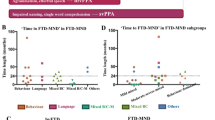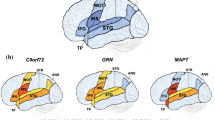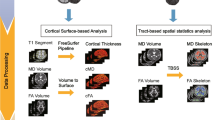Abstract
This study systematically investigated the neuropsychological profile of language disturbance in frontotemporal dementia–motor neuron disease (FTD–MND) using a data-driven approach. Neuroanatomical correlates of language profiles were also examined. Patients with FTD–MND (N = 26), pure motor neuron disease (N = 34), progressive non-fluent aphasia (N = 30), semantic dementia (N = 17), and controls (N = 31) underwent comprehensive language assessments. Clinical assessments were complemented with the Sydney Language Battery (SYDBAT), to assess semantic abilities, and the Test for Reception of Grammar (TROG), to assess syntactic comprehension. Two-step cluster analysis examined patterns of language impairment in FTD–MND and voxel-based morphometry investigated neuroanatomical differences between clusters. Almost all (88.5%) FTD–MND patients had language impairment, with anomia in 73.1% and impaired sentence comprehension in 56%. Cluster analysis revealed two main profiles of language impairment in FTD–MND; a mild mixed semantic and syntactic impairment (mild mixed subgroup) seen in 12 cases and a subgroup with more marked impairment particularly of syntactic comprehension (PNFA-like subgroup) seen in 7 cases. VBM revealed disproportionate atrophy of the caudate head and putamen bilaterally in the PNFA-like subgroup. In conclusion, language disturbances in FTD–MND are heterogeneous and more mixed than seen in FTD language phenotypes. Atrophy of the caudate and putamen was correlated with disproportionate impairment of syntactic comprehension. A pure semantic dementia like syndrome appears to be rare in FTD–MND.


Similar content being viewed by others
References
Elamin M, Bede P, Byrne S, Jordan N, Gallagher L, Wynne B, O’Brien C, Phukan J, Lynch C, Pender N (2013) Cognitive changes predict functional decline in ALS A population-based longitudinal study. Neurology 80(17):1590–1597
Montuschi A, Iazzolino B, Calvo A, Moglia C, Lopiano L, Restagno G, Brunetti M, Ossola I, Presti AL, Cammarosano S (2015) Cognitive correlates in amyotrophic lateral sclerosis: a population-based study in Italy. J Neurol Neurosurg Psychiatry 86(2):168–173
Burrell JR, Kiernan MC, Vucic S, Hodges JR (2011) Motor neuron dysfunction in frontotemporal dementia. Brain 134(9):2582–2594. https://doi.org/10.1093/brain/awr195
Burrell JR, Halliday GM, Kril JJ, Ittner LM, Götz J, Kiernan MC, Hodges JR (2016) The frontotemporal dementia-motor neuron disease continuum. Lancet 388(10047):919–931
Brettschneider J, Del Tredici K, Irwin DJ, Grossman M, Robinson JL, Toledo JB, Fang L, Van Deerlin VM, Ludolph AC, Lee VM-Y (2014) Sequential distribution of pTDP-43 pathology in behavioral variant frontotemporal dementia (bvFTD). Acta Neuropathol 127(3):423–439
Brettschneider J, Del Tredici K, Toledo JB, Robinson JL, Irwin DJ, Grossman M, Suh E, Deerlin VM, Wood EM, Baek Y (2013) Stages of pTDP-43 pathology in amyotrophic lateral sclerosis. Ann Neurol 74(1):20–38
Ringholz G, Appel SH, Bradshaw M, Cooke N, Mosnik D, Schulz P (2005) Prevalence and patterns of cognitive impairment in sporadic ALS. Neurology 65(4):586–590
Gibbons ZC, Richardson A, Neary D, Snowden JS (2008) Behaviour in amyotrophic lateral sclerosis. Amyotroph Lateral Scler 9(2):67–74
Phukan J, Elamin M, Bede P, Jordan N, Gallagher L, Byrne S, Lynch C, Pender N, Hardiman O (2012) The syndrome of cognitive impairment in amyotrophic lateral sclerosis: a population-based study. J Neurol Neurosurg Psychiatry 83(1):102–108
Saxon JA, Thompson JC, Jones M, Harris JM, Richardson AM, Langheinrich T, Neary D, Mann DM, Snowden JS (2017) Examining the language and behavioural profile in FTD and ALS-FTD. J Neurol Neurosurg Psychiatry 88(8):675–680. https://doi.org/10.1136/jnnp-2017-315667
Taylor LJ, Brown RG, Tsermentseli S, Al-Chalabi A, Shaw CE, Ellis CM, Leigh PN, Goldstein LH (2013) Is language impairment more common than executive dysfunction in amyotrophic lateral sclerosis? J Neurol Neurosurg Psychiatry 84(5):494–498
Leslie FV, Hsieh S, Caga J, Savage SA, Mioshi E, Hornberger M, Kiernan MC, Hodges JR, Burrell JR (2015) Semantic deficits in amyotrophic lateral sclerosis. Amyotroph Lateral Scler Frontotemporal Degener 16(1–2):46–53
Kamminga J, Leslie FV, Hsieh S, Caga J, Mioshi E, Hornberger M, Ballard KJ, Kiernan MC, Hodges JR, Burrell JR (2016) Syntactic comprehension deficits across the FTD-ALS continuum. Neurobiol Aging 41:11–18
Neary D, Snowden JS, Gustafson L, Passant U, Stuss D, Black S, Freedman M, Kertesz A, Robert P, Albert M (1998) Frontotemporal lobar degeneration A consensus on clinical diagnostic criteria. Neurology 51(6):1546–1554
Rascovsky K, Hodges JR, Knopman D, Mendez MF, Kramer JH, Neuhaus J, Van Swieten JC, Seelaar H, Dopper EG, Onyike CU (2011) Sensitivity of revised diagnostic criteria for the behavioural variant of frontotemporal dementia. Brain J Neurol 134(9):2456–2477
Gorno-Tempini ML, Hillis AE, Weintraub S, Kertesz A, Mendez M, Cappa S, Ogar J, Rohrer J, Black S, Boeve BF (2011) Classification of primary progressive aphasia and its variants. Neurology 76(11):1006–1014
Brooks BR, Miller RG, Swash M, Munsat TL (2000) El Escorial revisited: revised criteria for the diagnosis of amyotrophic lateral sclerosis. Amyotroph Lateral Scler Other Mot Neuron Disord 1(5):293–299
de Carvalho M, Dengler R, Eisen A, England JD, Kaji R, Kimura J, Mills K, Mitsumoto H, Nodera H, Shefner J (2008) Electrodiagnostic criteria for diagnosis of ALS. Clin Neurophysiol 119(3):497–503
Strong MJ, Abrahams S, Goldstein LH, Woolley S, Mclaughlin P, Snowden J, Mioshi E, Roberts-South A, Benatar M, HortobáGyi T (2017) Amyotrophic lateral sclerosis-frontotemporal spectrum disorder (ALS-FTSD): Revised diagnostic criteria. Amyotroph Lateral Scler Frontotemporal Degener 18(3–4):153–174
Gorno-Tempini ML, Brambati SM, Ginex V, Ogar J, Dronkers NF, Marcone A, Perani D, Garibotto V, Cappa S, Miller B (2008) The logopenic/phonological variant of primary progressive aphasia. Neurology 71(16):1227–1234
Mioshi E, Dawson K, Mitchell J, Arnold R, Hodges JR (2006) The Addenbrooke’s Cognitive Examination Revised (ACE-R): a brief cognitive test battery for dementia screening. Int J Geriatr Psychiatry 21(11):1078–1085
Hsieh S, Schubert S, Hoon C, Mioshi E, Hodges JR (2013) Validation of the Addenbrooke’s Cognitive Examination III in frontotemporal dementia and Alzheimer’s disease. Dement Geriatr Cogn Disord 36(3–4):242–250
So MFD, Kumfor F, Murray C, Hsieh S, Savage G, Ahmed RM, Burrell JR, Hodges JR, Irish M, Piguet O (2018) The Addenbrooke’s Cognitive Examination III: psychometric characteristics and relations to functional ability in dementia. J Int Neuropsychol Soc 24(8):854–863. https://doi.org/10.1017/S1355617718000541
Mioshi E, Hsieh S, Savage S, Hornberger M, Hodges JR (2010) Clinical staging and disease progression in frontotemporal dementia. Neurology 74(20):1591–1597. https://doi.org/10.1212/WNL.0b013e3181e04070
Strauss E, Sherman EM, Spreen O (2006) A compendium of neuropsychological tests: administration, norms, and commentary. American Chemical Society
Hodges JR (2007) Cognitive assessment for clinicians. Oxford University Press, Oxford
Lezak M, Howieson D, Bigler E, Tranel D (2012) Neuropsychological assessment, 5th edn. Oxford University Press, New York
Bowie CR, Harvey PD (2006) Administration and interpretation of the trail making test. Nat Protoc 1(5):2277–2281
Benton AL, Hamsher Kd (1983) Multilingual aphasia examination: manual of instructions. Dept. of Neurology and Psychology, University of Iowa, Iowa
Ogar J, Slama H, Dronkers N, Amici S, Luisa Gorno-Tempini M (2005) Apraxia of speech: an overview. Neurocase 11(6):427–432
Savage S, Hsieh S, Leslie F, Foxe D, Piguet O, Hodges JR (2013) Distinguishing subtypes in primary progressive aphasia: application of the Sydney language battery. Dement Geriatr Cogn Disord 35(3–4):208–218
Croot K, Hodges JR, Patterson K (1999) Evidence for impaired sentence comprehension in early Alzheimer’s disease. J Int Neuropsychol Soc 5(05):393–404
Mooi E, Sarstedt M (2011) Cluster analysis. A concise guide to market research. Springer, Berlin
Smith SM (2002) Fast robust automated brain extraction. Hum Brain Mapp 17(3):143–155
Zhang Y, Brady M, Smith S (2001) Segmentation of brain MR images through a hidden Markov random field model and the expectation-maximization algorithm. IEEE Trans Med Imaging 20(1):45–57
Andersson JL, Jenkinson M, Smith S (2007) Non-linear registration, aka Spatial normalisation FMRIB technical report TR07JA2. FMRIB Anal Group Univ Oxf 2:1–21
Nichols TE, Holmes AP (2002) Nonparametric permutation tests for functional neuroimaging: a primer with examples. Hum Brain Mapp 15(1):1–25
Irish M, Addis DR, Hodges JR, Piguet O (2012) Considering the role of semantic memory in episodic future thinking: evidence from semantic dementia. Brain 135(7):2178–2191
Onyike CU, Diehl-Schmid J (2013) The epidemiology of frontotemporal dementia. Int Rev Psychiatry (Abingdon Engl) 25(2):130–137. https://doi.org/10.3109/09540261.2013.776523
Hodges JR, Davies R, Xuereb J, Kril J, Halliday G (2003) Survival in frontotemporal dementia. Neurology 61(3):349–354
Sarstedt M, Mooi E (2014) Cluster analysis. A concise guide to market research. STBE. Springer, Heidelberg
Bak TH, Hodges JR (2004) The effects of motor neurone disease on language: further evidence. Brain Lang 89(2):354–361
Tsermentseli S, Leigh PN, Taylor LJ, Radunovic A, Catani M, Goldstein LH (2016) Syntactic processing as a marker for cognitive impairment in amyotrophic lateral sclerosis. Amyotroph Lateral Scler Frontotemporal Degener 17(1–2):69–76
Yoshizawa K, Yasuda N, Fukuda M, Yukimoto Y, Ogino M, Hata W, Ishizaka I, Higashikawa M (2014) Syntactic comprehension in patients with amyotrophic lateral sclerosis. Behav Neurol 2014:230578. https://doi.org/10.1155/2014/230578
Ash S, Menaged A, Olm C, McMillan CT, Boller A, Irwin DJ, McCluskey L, Elman L, Grossman M (2014) Narrative discourse deficits in amyotrophic lateral sclerosis. Neurology 83(6):520–528
Ash S, Olm C, Mcmillan CT, Boller A, Irwin DJ, Mccluskey L, Elman L, Grossman M (2015) Deficits in sentence expression in amyotrophic lateral sclerosis. Amyotroph Lateral Scler Frontotemporal Degener 16(1–2):31–39
Rakowicz WP, Hodges JR (1998) Dementia and aphasia in motor neuron disease: an underrecognised association? J Neurol Neurosurg Psychiatry 65(6):881–889
Bak TH, O’donovan DG, Xuereb JH, Boniface S, Hodges JR (2001) Selective impairment of verb processing associated with pathological changes in Brodmann areas 44 and 45 in the motor neurone disease–dementia–aphasia syndrome. Brain 124(1):103–120
Abrahams S, Goldstein L, Simmons A, Brammer M, Williams S, Giampietro V, Leigh P (2004) Word retrieval in amyotrophic lateral sclerosis: a functional magnetic resonance imaging study. Brain 127(7):1507–1517
Gorno-Tempini ML, Dronkers NF, Rankin KP, Ogar JM, Phengrasamy L, Rosen HJ, Johnson JK, Weiner MW, Miller BL (2004) Cognition and anatomy in three variants of primary progressive aphasia. Ann Neurol 55(3):335–346
Grahn JA, Parkinson JA, Owen AM (2008) The cognitive functions of the caudate nucleus. Prog Neurobiol 86(3):141–155
Crosson B, Benefield H, Cato MA, Sadek JR, Moore AB, Wierenga CE, Gopinath K, Soltysik D, Bauer RM, Auerbach EJ (2003) Left and right basal ganglia and frontal activity during language generation: contributions to lexical, semantic, and phonological processes. J Int Neuropsychol Soc 9(7):1061–1077
Ford A, Triplett W, Sudhyadhom A, Gullett JM, McGregor K, FitzGerald D, Mareci T, White K, Crosson B (2013) Broca’s area and its striatal and thalamic connections: a diffusion-MRI tractography study. Front Neuroanat 7:8
Teichmann M, Rosso C, Martini JB, Bloch I, Brugières P, Duffau H, Lehéricy S, Bachoud-Lévi AC (2015) A cortical–subcortical syntax pathway linking Broca’s area and the striatum. Hum Brain Mapp 36(6):2270–2283
Viñas-Guasch N, Wu YJ (2017) The role of the putamen in language: a meta-analytic connectivity modeling study. Brain Struct Funct 222(9):3991–4004
Brambati SM, Amici S, Racine CA, Neuhaus J, Miller Z, Ogar J, Dronkers N, Miller BL, Rosen H, Gorno-Tempini ML (2015) Longitudinal gray matter contraction in three variants of primary progressive aphasia: a tenser-based morphometry study. NeuroImage Clin 8:345–355
Acknowledgements
This work was supported in part by funding to Forefront, a collaborative research group dedicated to the study of frontotemporal dementia and motor neuron disease, from the National Health and Medical Research Council of Australia (NHMRC) program grant (#1037746) and the Australian Research Council (ARC) Centre of Excellence in Cognition and its Disorders Memory Program (#CE110001021). MI is supported by an ARC Future Fellowship (FT160100096). OP is supported by a NHMRC Senior Research Fellowship (APP1103258). JRB is supported by a NHMRC Early Career Fellowship (#1072451). We are grateful to the research participants involved with the ForeFront research studies.
Author information
Authors and Affiliations
Corresponding author
Ethics declarations
Conflicts of interest
On behalf of all authors, the corresponding author states that there is no conflict of interest.
Ethical approval
This study was approved by the South Eastern Sydney Local Health District and the ethics committees of the University of New South Wales and University of Sydney.
Informed consent
Written informed consent was obtained from all participants, or their caregivers, in accordance with the Declaration of Helsinki.
Electronic supplementary material
Below is the link to the electronic supplementary material.
Rights and permissions
About this article
Cite this article
Long, Z., Irish, M., Piguet, O. et al. Clinical and neuroimaging investigations of language disturbance in frontotemporal dementia–motor neuron disease patients. J Neurol 266, 921–933 (2019). https://doi.org/10.1007/s00415-019-09216-0
Received:
Revised:
Accepted:
Published:
Issue Date:
DOI: https://doi.org/10.1007/s00415-019-09216-0




